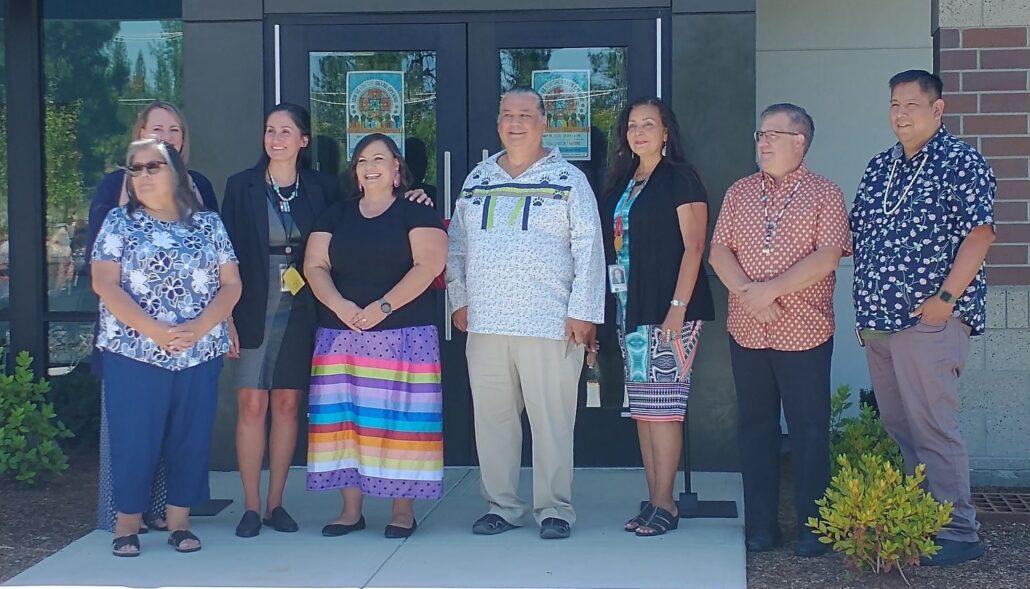Healing Lodge of The Seven Nations Expands Adolescent Services with New Facility
Contributions from FāVS from readers like you make this news story possible. Thank you.
News Story by Matthew Kincanon | FāVS News
On Friday afternoon, and on the feast day of St. Kateri Tekakwitha, the first Native American to be declared a saint in the Catholic Church, the Healing Lodge of the Seven Nations held a grand opening of its Family Wellness & Healing Center (FWHC) in Spokane Valley.
The new facility will provide adolescents and their families with medical, mental health and substance use services, explained Danielle Stensgar, FHWC’s clinical director and a citizen of the Colville Tribe.
“[The center] is really expanding our capacity to serve and allow more access to services for children, their families and the community all together,” Stensgar said.
The main clinic is a 45-bed adolescent residential chemical dependency treatment center in Spokane Valley that serves those between the ages of 13 and 17.
The New Facility
The new facility will provide outpatient mental health, outpatient substance use and medical service. This will allow the clinic to provide a comprehensive behavioral health service for children and their families, Stensgar explained.
“We’re very passionate about adolescents because we also know that adolescents don’t willingly, for the most part, want to have services,” Stensgar said. “Normally they’re required in some capacity, whether that’s court ordered or other outside influences.”
According to the National Center for Drug Abuse Statistics, Washington state teenagers are 33% more likely to have used drugs in the past month than the average teen.
For Native Americans ages 12 and older, the Substance Abuse and Mental Health Services Administration (SAMHSA) says the rate of lifetime alcohol use is 72%. Also, Pew Charitable Trusts says that Native Americans are three times as likely as the general population to die from an overdose.
“Anytime we hear those types of statistics it’s very heartbreaking and for people living in those communities we feel it. And we feel it all the time,” Stensgar said.
A Healthy Environment
Using a metaphor that paints a picture of what happens to kids who go back to unhealthy environments after treatment, Stensgar said that taking a sick tree from the forest and placing it into a healthy forest will make it well again. But if that same tree is placed back into the sick forest, it will likely become sick again.
“So for us, aftercare, transition planning, those types of services are super important, and how we support the transition from residential into an outpatient aftercare setting” Stensgar said. “And so for us we felt that this was a way that we can support them.”
Stensgar said the facility will also serve as a training institute as part of a partnership the clinic has with Harvard’s medical school. It will provide training to Tribal communities and any providers who work with Native communities, children and families to reduce the stigma of mental health.
The Process
During the ceremony, several speakers described the process behind developing the center and the challenges that came with it.

Stensgar said it was funded by a $2 million grant from the Washington State Department of Commerce. It was in development for four years. Two of those years were for construction of the building itself.
Rick Mathews, the facility’s architect and a citizen of the Spokane Tribe, said it was a challenging project from an architectural perspective. They had to make the center welcoming to clients, but were able to design it where it greeted clients in a comfortable fashion.
Despite also facing difficulties due to the COVID-19 pandemic, in the end they were able to construct a center where half of it was dedicated to medical and the other half for behavioral health.
A Drug-Free World
Several generations from now, Andy Joseph (the clinic’s board president) said their actions and what they do will make an impact and he hopes the clinic’s practices will create a drug-free world.
Other speakers at the event include Captain Marcus Martinez (IHS regional director), Pam Haley (Spokane Valley mayor), Jenny Slagle (Spokane School District tribal liaison) and Dr. Anthony Battaglia (FWHC medical director).
After the ribbon had been cut by Joseph, attendees were given tours of the new facility. Indigenous Eats provided lunch to attendees.
Pam Armtrout, a Seneca-Narraganset artist who created the artwork in the center’s lobby was in attendance. She said it was great that the center will treat patients and their families because the issues that the clinic treats are handed down from generation to generation.
“If they can stop that at this generation, when their kids grow up they’re not going to be like that; they’re just going leave all that behind,” Armtrout said.
Stensgar said they are excited about how the new facility will benefit the community for a long time and allow more people to have access to services.
Contributions from FāVS from readers like you make this news story possible. Thank you.









